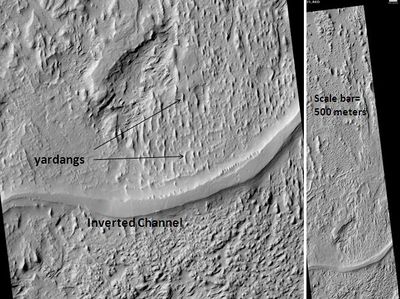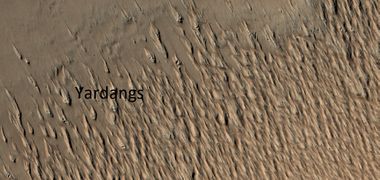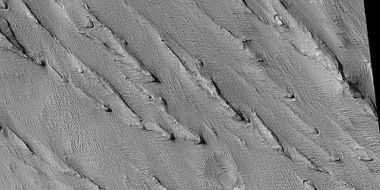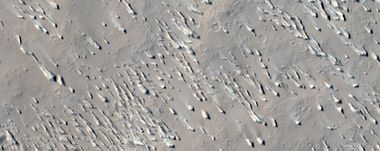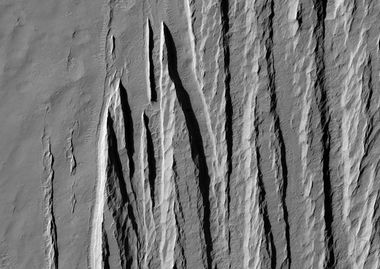Medusae Fossae
The Medusae Fossae Formation is a large geological formation of probable volcanic origin on the planet Mars.[1]
It is named for the Medusa of Greek mythology. "Fossae" is Latin for "trenches". The formation is a collection of soft, easily eroded deposits that extends off and on for more than 5,000 km along the equator.
Its roughly-shaped regions extend from just south of Olympus Mons to Apollinaris Patera, with a smaller additional region closer to Gale Crater.[2]
It has been determined that the Medusae Fossae Formation as the single largest source of dust on Mars|url=https://www.nature.com/articles/s41467-018-05291-5/figures/1%7Cjournal=Nature Communications|language=en|issn=2041-1723}}</ref>
The total area of the Medusae Fossae Formation is equal to 20% the size of the continental United States.[3]
The formation straddles what is called the martian dichotomy|highland - lowland boundary near the Tharsis and Elysium volcanic areas, and extends across five quadrangles: Amazonis, Tharsis, Memnonia, Elysium, and Aeolis.
Origin and age
The origin of the formation is unknown, but many theories have been presented over the years.
In 2020, a group of researchers headed by Peter Mouginis-Mark has hypothesized that the formation could have been formed from pumice rafts from the volcano Olympus Mons.[4] In 2012, a group headed by Laura Kerber hypothesized that it could have been formed from ash from the volcanoes Apollinaris Mons, Arsia Mons, and possibly Pavonis Mons.[5]
Its density and high content of sulfur and chlorine, suggests an explosive volcanic origin. It may have been deposited in periodic eruptions over an interval of 500 million years.[6]
The surface of the formation has been eroded by the wind into a series of linear ridges called yardangs. The wind shapes things by bouncing sand particles.[7] Layers are seen in parts of the formation. [8] These ridges generally point in direction of the prevailing winds that carved them, and demonstrate the erosive power of Martian winds. The easily eroded nature of the Medusae Fossae Formation suggests that it is composed of weakly cemented particles, and was most likely formed by the deposition of wind-blown dust or volcanic ash. Layers are seen in parts of the formation.[9]
Yardangs are common on Mars.[10] They are generally visible as a series of parallel linear ridges. Their parallel nature is thought to be caused by the direction of the prevailing wind.[11]
See also
- Geography of Mars
- High Resolution Imaging Science Experiment (HiRISE)
- HiWish program
- Layers on Mars
- Mars Global Surveyor
External links
References
- ↑ "The Medusa Fossae formation on Mars". European Space Agency. 29 March 2005.
- ↑ Lujendra Ojha; Kevin Lewis; Suniti Karunatillake; Mariek Schmidt (July 20, 2018). "Fig. 1, The Medusae Fossae Formation as the single largest source of dust on Mars". Nature Communications. ISSN 2041-1723.
- ↑ "The Medusae Fossae Formation as the single largest source of dust on Mars" (2018). Nature Communications 9 (1): 2867. doi:. PMID 30030425. Bibcode: 2018NatCo...9.2867O.
- ↑ Scientists Float a New Theory on the Medusae Fossae Formation". Eos. 19 May 2020.
- ↑ "The dispersal of pyroclasts from ancient explosive volcanoes on Mars: Implications for the friable layered deposits" (2012). Icarus 219 (1): 358–381. doi:. Bibcode: 2012Icar..219..358K.
- ↑ "The Density of the Medusae Fossae Formation: Implications for its Composition, Origin, and Importance in Martian History" (2018). Journal of Geophysical Research: Planets 123 (6): 1368–1379. doi:. Bibcode: 2018JGRE..123.1368O.
- ↑ Bridges, Nathan T.; Muhs, Daniel R. (2012). "Duststones on Mars: Source, Transport, Deposition, and Erosion". Sedimentary Geology of Mars. pp. 169–182. doi:10.2110/pec.12.102.0169. ISBN 978-1-56576-312-8.
- ↑ Template:Cite book
- ↑ Scott, David H.; Tanaka, Kenneth L. (1982). "Ignimbrites of Amazonis Planitia Region of Mars". Journal of Geophysical Research: Solid Earth. 87: 1179–1190. Bibcode:1982JGR....87.1179S. doi:10.1029/JB087iB02p01179
- ↑ Grotzinger, J. and R. Milliken (eds.) 2012. Sedimentary Geology of Mars. SEPM
- ↑ name="hiroc.lpl.arizona.edu"
